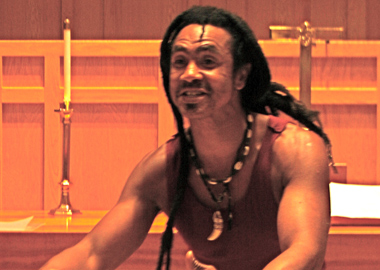People in the dark watching people in the light. Performers enacting a private reality while drawing their energy from the auditorium’s collective breath. The mysterious compact between actors and audiences, a shared understanding that without each other we don’t exist.
I ended my wrap-up of last summer’s theater season (“Nutritious Treats,” Sept. 1, 2011) with those words, and thought of them again while re-running 2011 in my mind’s eye. What I love most about live theater, what keeps me coming back for more, is precisely what separates it from movies and TV: its in-person immediacy and spontaneity.
And the theater I’m most attracted to is the kind that explicitly acknowledges that uniqueness—theater that breaks down the imaginary “fourth wall” between the stage and the auditorium and/or consciously breaks with its own conventions. My most memorable theater moments of the past year were shows that imaginatively exploited their own theatricality.
For example, Daniel Kramer’s pride@prejudice at Chester Theatre Company, which infused a crisp, funny five-actor dramatization of Jane Austen’s novel with Internet-derived commentary. Or Lisa Loomis’ Distracted at New Century Theatre, a witty satire of our “AD/HD society” whose fragmented style was a hyper-wired mirror of its subject. Serious Play’s The Tale of Lear used a compact ensemble, attired in tank-top workshop gear on a bare platform, to strip Shakespeare’s epic tragedy down to its elemental bones. At Hartford Stage, The 39 Steps (also in West Springfield’s Majestic Theater lineup next spring) gave the Hitchcock classic a slapstick twist that used theater’s conventions to spoof film noir’s.
Direct interaction with the audience, from broad asides to physical invasion, can seem forced or downright annoying. But The Venetian Twins and EveryActor at Shakespeare & Company employed both tactics to bring antique scripts to rollicking life. Four one-woman plays at the Ko Festival of Performance used direct address to connect their audiences with deeply personal stories. And the farcical One Man, Two Guvnors, beamed to the Valley from London’s National Theatre in Amherst Cinema’s NT Live series, wrote the last word on audience participation with an escalating sequence of fourth-wall-shattering gags.
Some performances dispensed with walls altogether and made their settings into the plays’ milieus. Jeannine Haas’ staging of Shiloh Rules in Goshen’s stone-walled Three Sisters Sanctuary made us believe we were on the field of battle in the play’s Civil War re-enactment. Hannah Simms’ vision of The Winter’s Tale with Hampshire Shakespeare’s Young Company moved the audience from the stage into an open field when the play’s action moved into the countryside. And spectators became participants in Double Edge Theatre’s The Odyssey, making the journey along with the actors all over the company’s Ashfield farm.
Nontraditional indoor settings likewise served as metaphorical or literal backdrops for performances. Ingrid Askew’s Crossing the Waters, Changing the Air, a meditation on the 1998 Interfaith Pilgrimage tracing the slave trade, was performed in a church. Joan Axelrod’s series of dinner theater mysteries were set, and performed, in Easthampton’s East Village Cafe.
When theater celebrates its very theater-ness, it becomes more than an entertainment, but an organic experience that we don’t simply watch, but share in. As the new year dawns, I’m looking forward to even more play-ful sharing with our region’s theaters.
Chris Rohmann can be reached at StageStruck@crocker.com.



